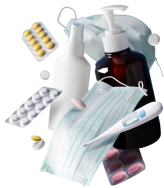Healthwire Pharmacy provides 100% genuine medicines straight to your doorstep.
Order Now! & Avail
Upto 10% OFF On All Your Pharmacy Orders!
Healthwire Pharmacy Ratings & Reviews (1500+)
Product Information
Sitagliptin is a medication that acts as a dipeptidyl peptidase-4 (DPP-4) inhibitor. DPP-4 is a type of enzyme found in the body that is responsible for breaking down hormones that help to regulate blood sugar levels. By inhibiting the action of DPP-4, sitagliptin helps to increase the levels of these helpful hormones, which in turn stimulates insulin production and lowers blood glucose levels. When taken orally, sitagliptin is absorbed into the bloodstream and actively works to inhibit the activity of DPP-4 enzymes. This inhibition is particularly important for two hormones, glucagon-like peptide 1 (GLP-1) and glucose-dependent insulinotropic polypeptide (GIP). These hormones, known as incretins, are responsible for stimulating insulin secretion and inhibiting glucagon secretion, both of which help to lower blood glucose levels. Normally, these incretins would be rapidly broken down after their release, but in the presence of sitagliptin, this breakdown is prevented, resulting in extended actions of these hormones.The increase in incretins due to the action of sitagliptin leads to stimulation of insulin secretion in a manner that depends on the current level of blood glucose. This means that insulin secretion is regulated accordingly, ensuring that blood glucose levels remain within a healthy range. Beyond its effects on glucose regulation, sitagliptin may also have other beneficial effects on body weight and cardiovascular risk factors due to the extended duration of action of incretins.
Dipeptidyl Peptidase-4 (Dpp-4) Inhibitors
Unveiling its multifaceted uses and transformative applications as follows:
Tailoring Treatment for Optimal Health, Prescribed Medication Dosage is:
Overdosing on Sitagliptin, especially at a dose of 100mg, should be considered a medical emergency in order to avoid potential harm to the patient. Sitagliptin is a medication prescribed to treat type 2 diabetes, and is typically prescribed in smaller doses, such as 50 or 100mg once daily. If a patient has taken an excessive dose of Sitagliptin, it is crucial to contact local emergency services or visit the nearest emergency room for appropriate medical care. In the case of an overdose, patients may experience a variety of symptoms including hypoglycemia (low blood sugar), nausea, vomiting, dizziness, diarrhea, and abdominal pain. Seeking emergency medical care can help prevent more severe symptoms and complications like hypoglycemic coma or pancreatitis.
It is crucial to adhere to the prescribed medication schedule for Sitagliptin, but there are actionable steps to take if you miss a dose. If you remember a missed dose within an hour or so of your usual dosing time, you should take it immediately, ensuring there is minimal delay between the usual timing and when you take the missed dose. Generally, it is not necessary to take an extra dose, and you can continue with your regular dosing schedule. However, if it has been longer than an hour since your usual dose timing, it is advised to disregard the missed dose and follow your typical dosing schedule. Taking multiple doses close together can unnecessarily raise the risk of side effects and will not provide additional benefits. To maintain stable treatment levels in your blood, merely taking the next dose at the regular time will be helpful. If you have any doubts or concerns, it is advisable to consult your physician or pharmacist to guide you on the best way forward.
Before you begin using Sitagliptin, it's important to read the dosage instructions provided by the manufacturer or your doctor. These instructions may vary from other medications, so it's important to follow the specific directions for this medication. To take the tablet, simply swallow it whole with a glass of water. Do not crush or chew the tablet. If you have difficulty swallowing, it's essential to inform your doctor, as there may be liquid or oral suspension alternatives available.It is typical to take Sitagliptin once per day, at the same time each day. You should take it consistently, with or without food, but it's important to be consistent with food or without food, to avoid an upset stomach. If you forget to take your dose, take it as soon as possible. However, if it is almost time for your next dose, skip the missed dose and continue on your regular schedule. Do not double up to catch up on the missed dose.It is important to only take Sitagliptin as prescribed by your doctor and only for the condition being treated. Keep the medication in a safe place, out of the reach of children and pets. If you have any questions or concerns about using Sitagliptin, it is always best to consult with a healthcare professional, pharmacist, or your doctor. They can provide more personalized and up-to-date directions to ensure you use the medication safely and effectively.
Discerning instances where this medication may not be appropriate:
Unraveling the side effects lurking behind this medications are as follows:
Sitagliptin is a medication prescribed to adults and children with type 2 diabetes to help lower their blood sugar levels. It works by blocking the breakdown of glucagon-like peptide 1 (GLP-1), a peptide hormone that helps stimulate the release of insulin and suppresses glucagon, both of which help to manage blood sugar levels. Sitagliptin is typically administered as a tablet to be taken orally, with or without food, and it's usually taken once daily. The specific dosage and regimen depend on the individual's medical condition, glucose levels, and response to the medication, so it's important to follow the instructions provided by a physician or healthcare provider. To ensure the efficacy and safety of Sitagliptin, it should be stored in a cool, dry place, away from heat and direct light. It should be kept out of reach of children and pets, and discarded if it has expired. It is not usually advised to freeze Sitagliptin tablets, and for disposal, it's recommended to consult with a physician or local healthcare center for guidance. In summary, Sitagliptin is a medication used to help manage blood sugar levels in those with type 2 diabetes. It works by affecting hormone levels that regulate insulin and blood sugar, is typically taken once daily, and should be stored safely and disposed of properly to ensure its efficacy and safety.
Lab tests are essential to monitor your health and ensure the medication is working effectively when taking Sitagliptin. These tests are necessary if you have diabetes mellitus and are taking Sitagliptin (100mg). Fasting Blood Sugar (FBS) and Postprandial Blood Sugar (PPBS) are regular blood sugar tests that monitor glucose levels before and after meals. Hemoglobin A1C (HbA1c) provides information about your blood sugar control over the past few months. Lipid Profile examines your cholesterol and triglyceride levels, while Kidney Function Tests assess your kidney function. These tests are crucial for diabetics as they are at risk of developing kidney disease and heart disease. Consult with your doctor to determine the target ranges for your blood sugar levels and hemoglobin A1C, which is typically between 7% and 8% for people with diabetes mellitus. You will need to maintain a healthy diet and exercise regularly to manage your lipid levels while taking Sitagliptin. Therefore, periodic lab tests are vital to monitor your health while taking Sitagliptin and ensure the medication effectively manages your diabetes mellitus.

Order Now! & Avail
Upto 10% OFF On All Your Pharmacy Orders!

If you face any issue, feel free to contact us. We provide 24/7 support to assist your problems